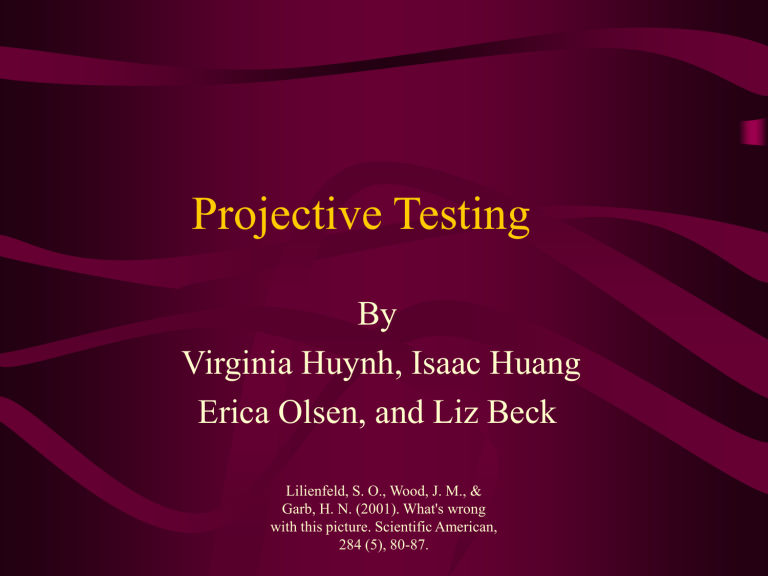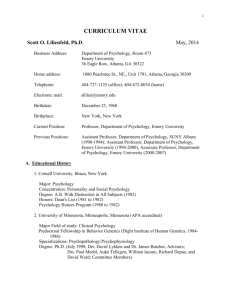Projective Testing

Projective Testing
By
Virginia Huynh, Isaac Huang
Erica Olsen, and Liz Beck
Lilienfeld, S. O., Wood, J. M., &
Garb, H. N. (2001). What's wrong with this picture. Scientific American,
284 (5), 80-87.
Lilienfeld, S. O., Wood, J. M., & Garb, H.
N. (2001). What's wrong with this picture.
Scientific American, 284 (5), 80-87.
Lilienfeld, S. O., Wood, J. M., & Garb, H.
N. (2001). What's wrong with this picture.
Scientific American, 284 (5), 80-87.
Lilienfeld, S. O., Wood, J. M., & Garb, H.
N. (2001). What's wrong with this picture.
Scientific American, 284 (5), 80-87.
Lilienfeld, S. O., Wood, J. M., & Garb, H.
N. (2001). What's wrong with this picture.
Scientific American, 284 (5), 80-87.
Lilienfeld, S. O., Wood, J. M., & Garb, H.
N. (2001). What's wrong with this picture.
Scientific American, 284 (5), 80-87.
Lilienfeld, S. O., Wood, J. M., & Garb, H.
N. (2001). What's wrong with this picture.
Scientific American, 284 (5), 80-87.
Projective Tests
• Assess the unconscious desires, emotions, experiences, memories and imaginations of individuals.
• Assess violent tendencies in convicts, mental stability of people, aggression in children, and sexual abuse in children.
• Tests often have little or no validity for these purposes.
Lilienfeld, S. O., Wood, J. M., & Garb, H.
N. (2001). What's wrong with this picture.
Scientific American, 284 (5), 80-87.
Rorschach Test
• First introduced by Swiss psychiatrist
Hermann Rorschach in 1920’s.
• Consists of 10 inkblots.
• Test was criticized in the 1950’ and 1960’s because of the lack of norms and standardized procedures.
Lilienfeld, S. O., Wood, J. M., & Garb, H.
N. (2001). What's wrong with this picture.
Scientific American, 284 (5), 80-87.
Rorschach Test (cont.)
• Psychologist John Exner, Jr. came up with the
Comprehensive System in an attempt to standardize and use norms for adults and children.
• Comprehensive System failed at scoring reliability and validity.
• Only half of the characteristics had interscorer reliability, making this test overall unreliable and invalid.
Lilienfeld, S. O., Wood, J. M., & Garb, H.
N. (2001). What's wrong with this picture.
Scientific American, 284 (5), 80-87.
Rorschach Test (cont.)
• Can detect thought disorders such as schizophrenia and manic depression.
– Can be detected in other valid and objective ways.
• Not equipped to identify psychiatric conditions.
• Not valid for detecting sexual abuse in children, violence, impulsiveness, criminal behavior.
• Unrepresentative of the general population, and therefore are subject to over-diagnosing psychiatric conditions.
Lilienfeld, S. O., Wood, J. M., & Garb, H.
N. (2001). What's wrong with this picture.
Scientific American, 284 (5), 80-87.
Thematic Apperception Test
• Client forms a story based on ambiguous pictures.
• Administration of the TAT is not standardized and clinicians usually interpret the results intuitively instead of using scoring procedures.
• Only 3% relied of clinicians who use the
TAT relied on the scoring system.
Lilienfeld, S. O., Wood, J. M., & Garb, H.
N. (2001). What's wrong with this picture.
Scientific American, 284 (5), 80-87.
Thematic Apperception Test (cont.)
• Weak test-retest reliability and questionable validity.
• Test does not differentiate psychotic or depressed individuals from normal.
Lilienfeld, S. O., Wood, J. M., & Garb, H.
N. (2001). What's wrong with this picture.
Scientific American, 284 (5), 80-87.
Draw-a-Person Test
• Requires the participant to draw a picture.
• Base their interpretation and analysis of the participant depending on the drawings characteristics.
• Psychologists often over-diagnose and people who lack artistic ability are more likely to be diagnosed with a mental illness.
Lilienfeld, S. O., Wood, J. M., & Garb, H.
N. (2001). What's wrong with this picture.
Scientific American, 284 (5), 80-87.
Conclusion
• Projective tests should be used in limited circumstances.
• Methods of assessment seem to lack incremental validity and empirically-based validity.
• Many innocent people suffer from the false diagnosis and the custody ruling and criminal court decisions based on these tests.
Lilienfeld, S. O., Wood, J. M., & Garb, H.
N. (2001). What's wrong with this picture.
Scientific American, 284 (5), 80-87.
Critiques
• The Rorschach test is poorly equipped to identify most psychiatric conditions, such as schizophrenia and bipolar disorder, but used so frequently during analysis (412 randomly selected clinical psychologists use it at least occasionally 82% of the time, and 43% use it always or frequently)
• researchers hide the negative results and continue to use the tests, and only ones that show validity get published.
• Psychologists mis-diagnose people who lack artistic ability with mental illness, even though
N. (2001). What's wrong with this picture.
Scientific American, 284 (5), 80-87.
Frequency of projective tests by clinical psychologists
90
80
70
60
50
40
30
20
10
0 frequently or always occasionally
Rorschach
TAT
Human Figure
Drawings
Lilienfeld, S. O., Wood, J. M., & Garb, H.
N. (2001). What's wrong with this picture.
Scientific American, 284 (5), 80-87.
Critiques
• Author says that projective tests are useful in certain circumstances, but didn’t say where.
Moreover, if these tests lack validity, how can it be useful?
• Talks about negative aspects only, presenting a biased and non-objective evaluation of projective tests
• Says must stop using projective tests, but is unrealistic. A better option is to persuade users to use it less because it is not valid
Lilienfeld, S. O., Wood, J. M., & Garb, H.
N. (2001). What's wrong with this picture.
Scientific American, 284 (5), 80-87.







